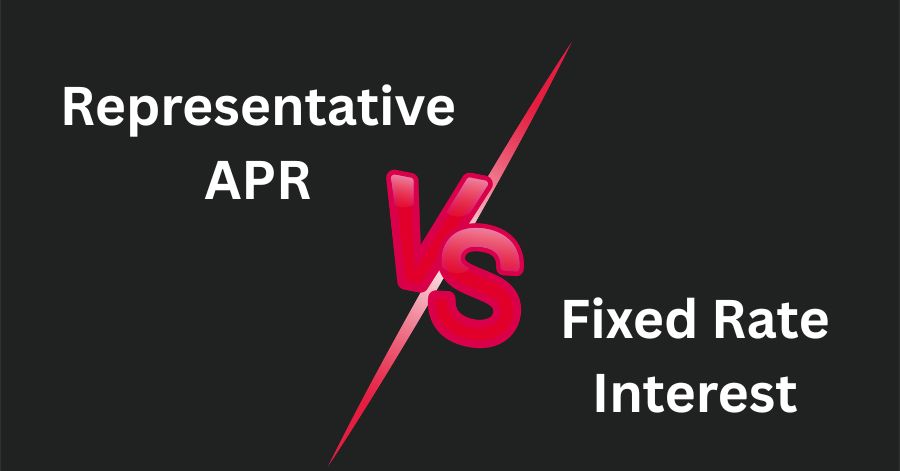Interest rates can be confusing, especially when different types are mentioned in loan offers and credit agreements. Knowing the difference between Representative APR and Fixed Rate Interest is crucial for anyone considering borrowing money.
This knowledge empowers you to make informed decisions, avoid costly mistakes, and secure the most suitable deal for your needs. In this guide, we break down the key features of both interest types, making it easy to understand which might be best for you.
Let’s clear up the jargon and get straight to the facts.
What is Representative APR?
Representative APR stands for Annual Percentage Rate, and it’s a term you’ll often see when searching for same day loans for direct lenders like Lending Stream or other types of credit. The APR gives you an idea of the overall cost of borrowing over a year, including both the interest rate and any compulsory fees.
However, “representative” means it’s the rate that at least 51% of applicants are likely to get. You might be offered a different rate, depending on your circumstances. Always read the terms carefully before agreeing to any loan based on APR alone.
What is Fixed Rate Interest?
Fixed Rate Interest means that the interest rate you pay on your loan or mortgage remains the same throughout the agreed period. This can be incredibly useful for budgeting, as your monthly payments will not change, even if market rates fluctuate. With a fixed rate, you have the certainty of knowing exactly what you owe every month.
However, it’s important to note that fixed rates sometimes start higher than variable rates, and there may be penalties if you decide to repay early or switch deals before the term ends.
Key Differences Between Representative APR and Fixed Rate Interest

The biggest difference between Representative APR and Fixed Rate Interest is what they represent. Representative APR shows the overall yearly cost of borrowing, including interest and fees, but may not be the actual rate you receive.
Fixed Rate Interest, meanwhile, refers specifically to the interest portion of your payment, and this remains unchanged during the fixed term. While APR gives a broader picture of loan costs, a fixed rate provides payment predictability.
Knowing both helps you compare loans more accurately and plan your finances with confidence.
Pros and Cons of Representative APR
One of the main advantages of Representative APR is transparency. Lenders are required by law to display it, so you can compare the “true” cost of different loans more easily. However, the downside is that the rate shown is not guaranteed for everyone, and many borrowers end up with a higher rate than advertised.
APR also includes compulsory fees, but it might not cover all potential costs, such as early repayment charges. Always double-check the full breakdown to ensure you are getting the complete picture.
Pros and Cons of Fixed Rate Interest
Fixed Rate Interest provides stability and peace of mind, making it ideal for those who want predictable monthly payments. This is particularly useful for people on a tight budget or with fixed incomes.
However, fixed rates can sometimes be higher than variable alternatives, especially if you lock in during periods of high interest rates. You might also face penalties if you pay off your loan early or switch to another deal before your fixed term ends.
Consider your long-term financial plans before choosing a fixed rate product.
When Should You Choose Representative APR?
Choosing a loan based on Representative APR is beneficial when comparing different lenders and products. It gives you a standard measure to judge the yearly cost, helping you spot the best-value deals.
If you’re seeking transparency in overall costs and want to weigh up loans with different fees and charges, APR is invaluable. However, always remember that you might not get the advertised rate.
Check the eligibility criteria and understand how your credit history might affect the offer you receive.
When Should You Choose Fixed Rate Interest?
Fixed Rate Interest is a good choice if you value certainty and need to plan your finances without the risk of payment increases. It’s especially useful for long-term loans or mortgages, where rate fluctuations could significantly impact your monthly outgoings.
If you prefer knowing exactly what you will pay each month, a fixed rate could suit you perfectly. Just be mindful of any early repayment penalties or restrictions that may apply during the fixed term. Always read the fine print before committing.
How to Decide Which is Right for You

Deciding between Representative APR and Fixed Rate Interest depends on your financial goals, risk tolerance, and need for flexibility. If you prioritise knowing your overall yearly costs and comparing lenders, focus on APR. If budgeting certainty and stable payments matter more, a fixed rate is the better option.
Assess your income, future plans, and how likely you are to want to switch or repay early. Seeking impartial financial advice can also help you make the most informed choice for your situation.
Final Words
Understanding the difference between Representative APR and Fixed Rate Interest can save you money and prevent future financial stress. Both have unique advantages and are suitable for different situations. By considering your priorities and reading the small print, you’ll be well equipped to select the best borrowing option. Take your time, compare offers, and never hesitate to seek professional guidance if you’re unsure. Your financial peace of mind is worth the effort.
FAQs
Can my interest rate change if I have a fixed rate loan?
No, with a fixed rate loan, your interest rate remains the same throughout the agreed term, regardless of market fluctuations.
Is Representative APR always the rate I’ll receive?
Not necessarily. The Representative APR must be given to at least 51% of successful applicants, but your actual rate may differ depending on your credit profile.
Are there penalties for early repayment on fixed rate loans?
Many fixed rate loans include early repayment charges. Always check the loan agreement’s terms before making extra payments or settling early.
Which is better for budgeting: APR or fixed rate?
A fixed rate is better for strict budgeting, as your payments remain stable. APR helps compare overall costs but doesn’t guarantee monthly payment consistency.




















